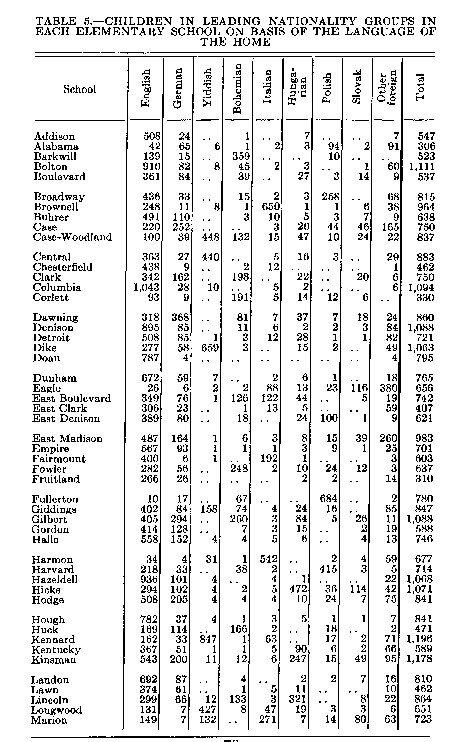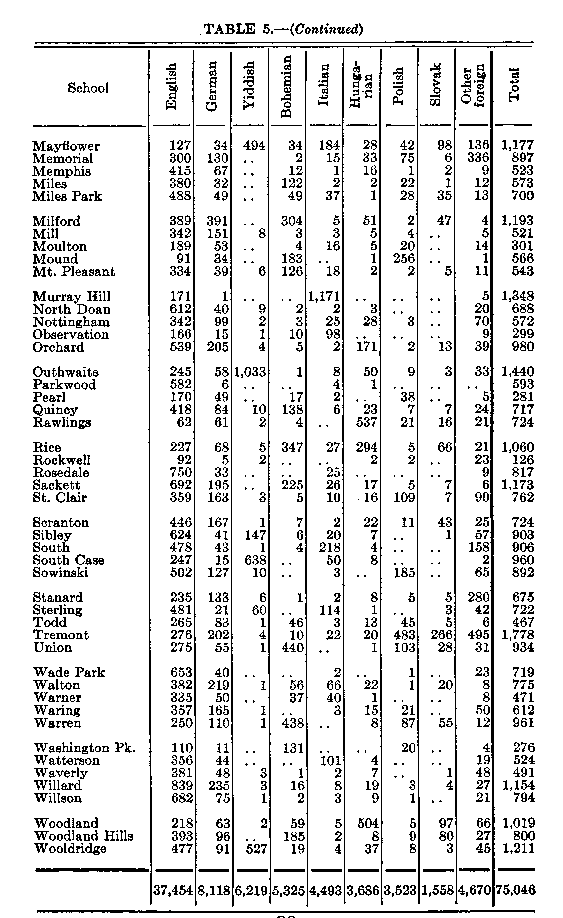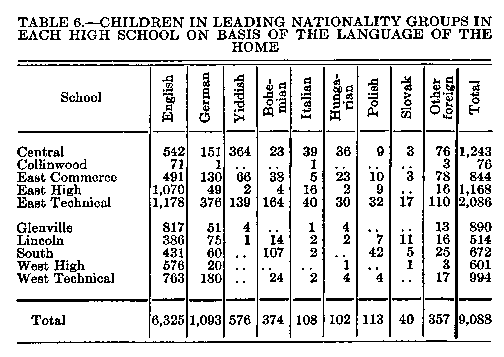The School and the Immigrant
Chapter 5: The Problem of Education for the Foreign Children
Herbert A. Miller
Table of Contents | Next | Previous
The problem of educating children of recent foreign origin divides itself into two major phases and almost innumerable minor ones. The two main divisions of the problem have to do respectively with education for the recently arrived non-English-speaking children; and with the far greater number of children scattered throughout the school system who come from homes where English is not spoken but who have themselves acquired some facility in the use of the language and some familiarity with American customs and standards.
STEAMER CLASSES
Fifteen years ago, in 1901, the Cleveland school system first recognized the necessity of making special provision for teaching English to recently arrived immigrant children. In that year the principal of Harmon School organized the first clans for non-English-speaking children and termed it a "Steamer Class" because it was
(73) made up of pupils who had come to Cleveland directly from the steamer which brought them to this country. The name has persisted and ever since that day the special classes for non-English-speaking children in the day schools have been known as steamer classes.
The value of this educational innovation soon became apparent. Children who cannot speak English are misfits in the regular grades. They must be given an opportunity to learn the language before they are placed in a class of 40 or more other children and expected to carry on regular grade work. Unfortunately, the steamer class cannot become a very effective instrument for assisting recently arrived immigrant children until further provisions are made for transporting such children to these special classes whenever they happen to enroll in schools where provision for teaching them has not been made.
Under the present arrangements steamer classes are organized in the schools that regularly receive large numbers of new immigrants. Here they meet an important need, but they do not help the pupil whose parents have found a place to live a little removed from the other recent arrivals and so have sent their children to a school where there are not enough foreign children in attendance to warrant the establish-
(74) -ment of special classes. This is one of the problems which the school system has never satisfactorily solved.
At the present time such cases are often handled in a most unsatisfactory manner. The non-English-speaking child cannot keep up with his companions in the regular grades. For this reason he is sent to a special class, but if there is no steamer class available, the pupil is all too frequently assigned to the backward elms. This is not because the backward class is the right place for him, but rather because it furnishes an easy means of disposing of a pupil who, through no fault of his own, is an unsatisfactory member of a regular grade, holds back the other pupils, and makes the teacher's work more difficult and less effective.
Attention has already been directed to some of these problems in the report of the Survey entitled "Schools and Classes for Exceptional Children." That report discusses cases in which mentally deficient children are assigned to foreign classes, and normal foreign children to classes for backward pupils because the school organization has not been sufficiently flexible and sufficiently discriminating to examine each child carefully, diagnose his case accurately, and then see to it that he is assigned to a class which will give him the particular sort of
(75) instruction he needs and that he is transported to such a class if one is not available in his own building.
The truth is that the problem of teaching foreign children to speak English has never been regarded by the public schools as one of their serious problems. Although classes for these children have been in existence for the past 15 years, it is only during the past two years that the statistical summaries of the annual school reports have shown the number of pupils and teachers in them. Moreover, during the entire period of 15 years the work of these classes has never been of sufficient importance to receive mention in the annual reports of the superintendent and board.
The data that are available indicate that in 1915 there were 15 classes with more than 400 children enrolled. In 1914 and 1915 the number of classes was about 25 and the number of pupils a little over 700. Toward the close of 1915 these figures were very much reduced because the European war resulted in largely cutting off the stream of immigration to this country. The effects of the war were still more fully felt in 1916 so that in the spring of that year almost all the steamer classes had been suspended.
The educational officers of the city have never
(76) worked out any special methods for teaching English to these non-English-speaking children. There is no special supervision of the work and no provision in the Normal School for training teachers to do it. As a result the classes are far less efficient than they should be. There is a special educational technique for teaching a new language which is far different in its methods from that employed in teaching subject matter to pupils in their own language. This has been amply demonstrated in the special classes of several of our cities, notably New York and Boston, and still more strikingly illustrated in the schools of Porto Rico and the Philippines, in which hundreds of thousands of children are taught the English language so effectively that they successfully carry on their entire school work in it after a remarkably short period of special teaching.
The school systems of these insular possessions have developed methods of language teaching incomparably more effective than those in use in our American school systems and vastly more efficient than any commonly employed in our high schools or colleges. In the lesson of their experience the fact which stands out with most impressive clearness is that the problem of teaching children a new language is one of great difficulty when attempted by traditional
(77) school methods and one of remarkable ease and celerity when the proper special methods are employed.
In view of the great importance of English teaching in the schools of Cleveland, the Board of Education ought to take vigorous steps to increase the efficiency of this work. Two steps are urgently needed. The first is to secure a supervisor thoroughly conversant with the most effective methods of teaching English to non-English-speaking children. Through the services of such a supervisor a trained corps of teachers could soon be developed.
The second important step is to provide the administrative readjustments necessary to put every non-English-sneaking child into a special clam, even if this involves transportation from one district to another. In this connection special care should be taken to avoid assigning foreign children of normal mentality to backward classes or backward English-speaking children to foreign classes.
ENGLISH-SPEAKING CHILDREN FROM NON-ENGISH-SPEAKING HOMES
It has already been shown that more than half of the children in the schools of Cleveland come from non-English-speaking homes. A study of
(78) the figures showing how these children are distributed through the different grades and among the various schools leads to the conclusion that the only uniform condition permeating the entire situation is the universal heterogeniety of the school population. There are very few schools indeed having anything approaching a homogeneous student body. In every school there are children from non-English-speaking families, and in most of them these children are divided among a large number of nationalities. Moreover, some schools have large numbers of foreign children in the upper grades while in others they are mainly in the lower ones. In some schools one nationality predominates among the older children and another among the younger ones. The school population is a synthesis of the most varied elements. Tables 5 and 6 are introduced to show the numbers of children of the more important nationality groups in the different schools from which data were gathered by the Survey.
A study of Table 5 reveals conditions that are not only interesting, but constitute a very puzzling educational problem. The data were gathered from 98 elementary schools. In a majority of cases the children from non-English-speaking homes outnumber those from English-speaking homes. It would thus seem on first
(79)

( 80)

(81) consideration that it would be a comparatively simple matter to modify the instruction given in each school so as to meet most adequately the needs of the pupils. In point of fact this is rendered exceedingly difficult by the complex character of the group from non-English-speaking homes.

In the city as a whole the only homogeneous element in the different school populations is the group of children from English-speaking homes. They do not constitute a majority of all the children, but, except in a few cases, they constitute a larger group than any other single group. In the entire city there are 26 schools in which there is a group of one nationality out-
(82) -numbering the children from English-speaking homes, but in most cases these children do not constitute a majority of the children enrolled in the school.
In only 11 schools are there homogeneous foreign groups so numerous as to constitute more than half of the children enrolled. Six of these schools have groups of children from Yiddish-speaking homes so large as to constitute a majority of the whole school enrollment; in two cases the Polish children are in the majority; in two cases the Italians; and in one case the Hungarians.
Such facts as these, together with the data of Table 5, indicate the great difficulties involved in attempting to modify instruction to meet the special needs of special national groups. In a single classroom there may be pupils of a dozen different nationalities. In most of the classrooms of the city the largest single group is made up of children from English-speaking homes. In only a few cases are there classes in which practically all the children are of the same nationality.
Nevertheless the very complexity of the problem points the way with some definiteness to certain wise courses of educational procedure. It is entirely certain that in a city in which a majority of the children are from non-English-
(83) -speaking homes a definite and conscious effort should be made by the school authorities to acquire an intelligent understanding of the national origins, traditions, histories, and aspirations of the more important immigrant groups. Teachers and principals should cultivate a more intelligent and sympathetic understanding of the home problems and conditions of these children.
In addition to these general considerations, there are certain definite and specific courses of action which are indicated by the conditions that have been discussed. It is apparent that the most important subject in the schools of Cleveland is English. This would probably remain true if there were no foreign children enrolled, but under the present conditions it is doubly true. The one educational certainty is that the ability to read, write, and speak the English language easily and correctly is the ability which will conduce most effectively to the moral welfare, the cultural development, the vocational prosperity, and the individual happiness of this great mass of children now in the public schools of this city.
SUMMARY
The problem of educating immigrant children has two major phases: teaching them English,
(84) and teaching them after they have learned English. For the purpose of teaching them English, Cleveland began 15 years ago the establishment of steamer classes, which increased in number until in the past year they enrolled some 700 children in 25 classes.
These classes are valuable and fairly effective. Provisions should be made for transferring non-English-speaking children to them when such children enroll in schools where steamer classes have not been organized. The work could be rendered much more effective by adopting methods of English teaching such as have been developed in New York and Boston, or the superior methods in use in Porto Rico and the Philippine Islands.
The problems of furnishing the best schooling for the foreign children after they have learned to speak English are rendered difficult by the large numbers of national groups and the complex manner in which they are scattered through the schools all over the city. The one educational certainty is that the most important single educational asset that the schools could give all the children, whether they come from English-speaking or non-English-speaking homes, would be a mastery of speaking, reading, and writing the English language.